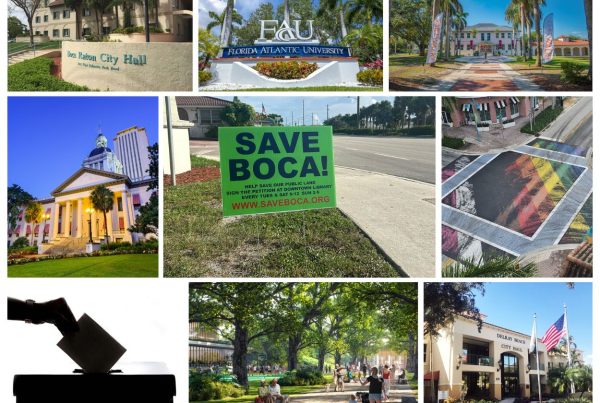Getting high(er) in Boca

Depending on your perspective, the Boca Raton City Council this week either made a sensible decision that will help the city’s downtown or showed residents that their concern about the downtown is justified.
The issue for the council, acting as the Community Redevelopment Agency, was whether to approve a new design for the Tower One Fifty-Five condo that adds 40 feet of height. The 4-1 approval wasn’t surprising; Compson Associates could not have asked for the extra height if the council hadn’t already reduced from 2 acres to 1.2 acres —strictly for Compson—the minimum size of parcels that could go taller by using the city’s design guidelines
The argument for Tower One Fifty-Five:
A project that began with 209 units and then dropped to 192 units was now seeking 170 units. Fewer units will mean fewer residents, and thus less traffic. Since the developers could have built an office project, which would have generated far more traffic, Tower One Fifty-Five won’t create a bottleneck on East Boca Raton Road. In fact, the project will have more parking spaces than required.
Also, the city’s consultants and staff praised the design of Tower One Fifty-Five. Council supporters said the city adopted those design guidelines to preserve the look that residents like. There will be no setback issues.
Finally, as Councilman Mike Mullaugh argued, all the other residential downtown residential projects under construction or just completed are rentals. Tower One Fifty-Five will add the high-income, long-term downtown residents Boca Raton needs for downtown businesses. Overall, this project is much better than the one the council approved two years ago.
The argument against Tower One Fifty-Five:
The developers played the usual game. They acted as though they were helping the city when they really were helping themselves. There will be fewer units, but they will be more expensive units, meaning the developers’ profit potential will be greater. The 10-foot ceilings now possible will raise sale prices.
Despite all the praise for the design, the taller building—the easternmost of the three towers—will be too high for that low-rise neighborhood on the edge of downtown. The neighbors weren’t crazy about the 100-foot project; now they will get a taller one. Why not delay a decision until the city can evaluate theMark at Cityscape, which also got the extra height by using design guidelines—on a larger site?
Finally, this is just Boca politics. The council changed the rule to please a company that donates to political campaigns. Councilman Robert Weinroth responded to a Facebook posting of his donations by saying that the money “doesn’t cloud my judgment.” Last September, Weinroth received $2,000 from James and Robert Comparato, the principals of Compson Associates, and from the company. As it turned out, Weinroth was unopposed for reelection.
Mullaugh, Weinroth, Constance Scott and Scott Singer voted for the approval. Mayor Susan Haynie voted no. As she stated earlier, Haynie worried about the precedent.
Then there’s public cynicism. When residents complain about the pace and size of downtown building, Haynie and other council members respond—correctly—that the council is following a plan approved two decades ago on how much development the city would allow. Even with all the current projects, downtown is not built out.
But the next council will have to deal with New Mizner on the Green, which could be the most controversial project in recent memory. As Haynie said Wednesday, Tower One Fifty-Five did not present a height issue like New Mizner on the Green, “but it is an issue of added height.” Haynie agreed that “it’s a beautiful building,” and said James Comparato “is one of the best developers in South Florida.” But, Haynie said, “All the things they said they could do with a 140-foot building they could have done with a 100-foot building.”
Haynie noted that city staff will do that evaluation of the Mark in April. Boca Raton will wait to see whether Tower One Fifty-Five’s supporters or critics were right.
New face in the race
Delray Beach’s March 10 city commission election continues to be fluid.
Chris Davey had withdrawn from the Seat 3 race, leaving just Christina Morrison and Bruce Bastian. But on Tuesday, the first day of qualifying, Mitchell Katz again made it a three-candidate race.
Katz told me Wednesday that he had been prepared to support Davey. When he learned that Davey had to drop out because of a family emergency, Katz talked with his wife last weekend and decided to get in, even though he had done nothing to organize a campaign.
“I wouldn’t run against (Mayor) Cary (Glickstein) or (Commissioner) Shelly (Petrolia),” Katz said. Both are on the ballot. “I have too much respect for them.” All seats are at-large, and Katz got into Seat 3 “because I felt that the two candidates weren’t the best for the city.”
Katz moved to Delray Beach 13 years ago after “falling in love with my wife and the city” on the same night—their first date, at Boston’s on the Beach. They live in Bexley Park, in northwest Delray, and Katz says he would be the first commissioner who lives west of Interstate 95 in nearly a decade. Pat Archer was the last. (For comparison, three of Boca Raton’s five commissioners live west of I-95. So does City Manager Leif Ahnell.)
Meanwhile, Victor Kirson withdrew from the Seat 1 race against Petrolia. If no one else qualifies by the Feb. 10 deadline, the two incumbents will be unopposed. Seat 3 incumbent Adam Frankel is term-limited.
And still more trash talk
As expected, the Delray Beach City Commission on Tuesday substituted itself for the selection committee that had ranked the five bidders for the city’s trash-hauling contract. The move makes it more likely that the losing company will file a bid protest, but it also makes it more likely that the selection will be credible and transparent.
Though Southern Waste Systems submitted the lowest bid, the five-member committee ranked Waste Management first and Southern Waste Systems second. Under rules set up by the interim city manager, who appointed the committee last year, price counted just 50 percent of the decision. Other factors, such as service record and equipment, counted a combined 50 percent. Assistant City Manager Francine Ramaglia chaired the selection committee.
On last week’s agenda was an item asking for the commission to approve the committee’s recommendation. The commission delayed that decision because of a possible violation of the bidding rules. We discussed that in Tuesday’s post, and there isn’t much new to say until the city completes investigation into emails involving Waste Management and some of the company’s supporters.
Another issue last week, though, was that the selection committee did not provide sufficient explanation of how those other factors enabled the committee to rank Waste Management first. In addition to service and equipment was the vague “Any other relevant information.”
What does that mean? What “relevant information” did the committee consider? How much weight did the committee give that “relevant information?” There might have been good reasons to recommend that Delray Beach stay with the company that has been providing service without previously having to bid for it, even at a higher cost. Judging by their comments, though, the residents didn’t hear that persuasive “relevant information,” even after Chief Financial Officer Jack Warner’s presentation. There also are questions about late changes that narrowed the price gap between the two companies.
So next Wednesday, the commissioners will hear presentations from the companies, and then set a date to make their rankings. One big issue will be how the commissioners first determine their individual rankings and then the commission’s collective ranking.
“I think there will be a lot of discussion after the presentations,” Commissioner Shelly Petrolia said, “and we will find a fair and balanced way to rank.” If that happens, it will be less likely that a bid protest succeeds.
How big are we?
How big is South Florida? As an economy, Palm Beach, Broward and Miami-Dade counties would rank 41st in gross domestic product worldwide if we were a country.
According to a new report from the Brookings Institution’s Global Metro Monitor, the South Florida economy is a roughly $262 billion engine. For perspective, greater New York City’s economy is roughly $1.4 trillion. Of course, business leaders in this area are keen to get some of that hedge fund industry here.
Also for perspective, the South Florida economy still is 0.4 percent below where it was at the start of the Great Recession. Employment has come back better. It’s nearly 2 percent higher than it was in 2009. That’s good, but far from really good, and it likely indicates that the new jobs pay less than the jobs we lost.
••••••••
You can email Randy Schultz at randy@bocamag.com
For more City Watch blogs, click here.About the Author
Randy Schultz was born in Hartford, Conn., and graduated from the University of Tennessee in 1974. He has lived in South Florida since then, and in Boca Raton since 1985. Schultz spent nearly 40 years in daily journalism at the Miami Herald and Palm Beach Post, most recently as editorial page editor at the Post. His wife, Shelley, is director of The Learning Network at Pine Crest School. His son, an attorney, and daughter-in-law and three grandchildren also live in Boca Raton. His daughter is a veterinarian who lives in Baltimore.







